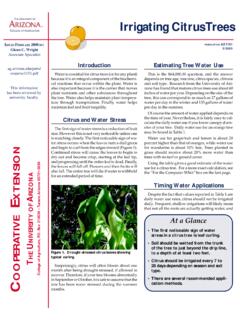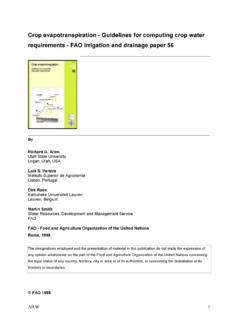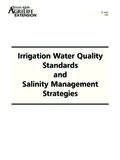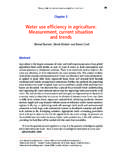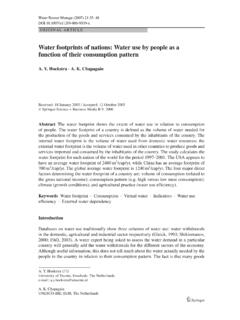Transcription of Drip Irrigation: The Basics
1 Drip irrigation also known as low-flow, micro, and trickle irrigation is the slow, measured application of water through devices called emitters. It is the most efficient way to irrigate. A wide variety of quality products has been developed to make drip irrigation reliable and easy to use for almost any landscape situation. Why should I use drip irrigation ? Drip irrigation saves water because little is lost to runoff or evaporation. This watering method, if implemented correctly, promotes healthy plant growth, controls weed growth, and reduces pest 01/16az1392 Drip irrigation : The BasicsUrsula SchuchWhat types of landscapes are bestsuited for drip irrigation ? Most of your landscape can be watered with drip irrigation except for turf areas. Drip systems are particularly well suited for desert landscapes, places where runoff can be a problem, and small, narrow areas such as is also a great way to water vegetable gardens, fruit trees, and potted is a wide assortment of equipment to suit most budgets and watering micro-tube delivers water to the root zone of the tree.
2 Under ground, it is attached to an emitter connected to a polyethylene lines are a type of micro-tubing with emitters embedded inside the drip emitter is connected to micro-tubing which is attached underground to a lateral tape has emitters inside the tubing and is connected to a polyethylene line. It is used for vegetable gardens or annual flower University of Arizona Cooperative ExtensionWhat are the components of a drip irrigation system?Controller/ Timer:Controllers or timers are also called irrigation clocks. They are programmed to automatically turn on control valves for a specific amount of time and for certain days. This determines how often and for how long the irrigation system is turned on. Backflow Preventor:This prevents water in the irrigation system from flowing back into the potable water supply.
3 Backflow preventers are required for all irrigation systems and installation is regulated by county, municipal, or local :Valves turn the water in the irrigation system on or off. They can be manually or automatically operated and are wired to the irrigation :Filters screen particles out of the irrigation lines to maintain a clean water supply. Even small particles can plug the small openings of emitters and restrict or block water Regulator:Drip systems require low pressure of about 20 psi. A pressure regulator reduces the incoming water pressure which can range from 50 to 75 psi for most water supplies to levels suitable for a drip :Rigid PVC (polyvinyl chloride) pipe and flexible polyethylene tubing are commonly used for lateral irrigation lines. These lines are generally buried in the soil.
4 Micro-Tubing:These lines are also known as inch or spaghetti tubing and deliver water from the lateral lines to the emitters or directly to the plant. The length of micro-tubing from the lateral line to the plant should not exceed 5 feet. Emitters:They deliver water to the plants at slow rates, usually at , 1, 2, or 4 gallons per hour (gph). Emitters are either located at the end of the micro tubing or between the polyethylene tubing and micro-tubing. In drip tape or polyethylene drip lines emitters are located inside the lines spaced at various intervals. Flush Valve/ Cap:Flush caps are attached to the end of each lateral line. They are removed periodically to flush particles and debris from the irrigation laterals. Can I design my own drip irrigation system? Yes, designing your own drip system is not difficult to do, but it does require some careful planning.
5 Make a drawing of the final installation design of your system, and keep it for your records. Group plants with similar water requirements such as trees, shrubs, ground covers and turf on separate valves. Know the number of plants for each type and their water requirements. Design with consideration to pipe length, size and elevation changes. Plan to expand your irrigation system as plants grow. Move emitters out to the edge of the canopy (dripline) where roots will take up water . Evaluate whether you need more emitters or change existing emitters to deliver more water at a faster rate. Select quality equipment. Spending a little money up front will save time and money later. Local irrigation suppliers are a good source of sprinklers be converted to a dripsystem?Yes, there are products that can be installed in place of sprinkler heads.
6 Keep in mind that sprinklers and drip emitters apply water at different rates. When converting to a drip system, all sprinklers in the same zone and on the same valve need to be changed. Sprinkler and drip irrigation apply water at different rates and operate under different pressure, requiring separate valves. Drip systems need a pressure reducer and a filter to protect drip emitters from high pressure and Follow manufacturer s installation recommendations. Set and change watering schedules according to plant water need, weather and seasons, and soil texture. Keep filters clean and flush system periodically. Visually inspect emitters and lines monthly to ensure proper water delivery. Expand your system as the plants grow. Keep good records of your installation design. Winterizing your drip system may be necessary in cold areas to prevent freeze Watering Time3 The University of Arizona Cooperative ExtensionZonesSmall shrubs andgroundcoversVegetable gardenTrees and largeshrubsThis drip irrigation system has three valves for plants with different water needs.
7 Vegetables are watered most frequently with drip tape installed in the bed. Small shrubs and groundcovers have individual drip emitters with low flow rates ( or 1 gph). Trees and large shrubs have multiple emitters with higher flow rates (4 gph) and are watered deep and University of Arizona Cooperative ExtensionAny products, services or organizations that are mentioned, shown or indirectly implied in this publication do not imply endorsement by The University of in furtherance of Cooperative Extension work, acts of May 8 and June 30, 1914, in cooperation with the Department of Agriculture, Jeffrey C. Silvertooth, Associate Dean & Director, Extension & Economic Development, College of Agriculture Life Sciences, The University of University of Arizona is an equal opportunity, affirmative action institution. The University does not discriminate on the basis of race, color, religion, sex, national origin, age, disability, veteran status, or sexual orientation in its programs and UniversiTy of ArizonACollege of AgriCUlTUre And life sCienCesTUCson, ArizonA 85721roberT e.
8 CAll Former Extension Agent, HorticultureCAdo dAilyRetired Coordinator, water Resourcesrevised by:UrsUlA sChUCh Professor and Specialist, HorticultureConTACT:UrsUlA information has been reviewed by University published: 2006 Other titles from Arizona Cooperative Extension can be found questions about irrigation or water conservation assistance, contact your local Cooperative Extension :Arizona Landscape irrigation Guidelines Committee. 2001. Guidelines for Landscape Drip irrigation Systems. with permission from the Arizona Municipal water Users Association s Drip irrigation brochure.
